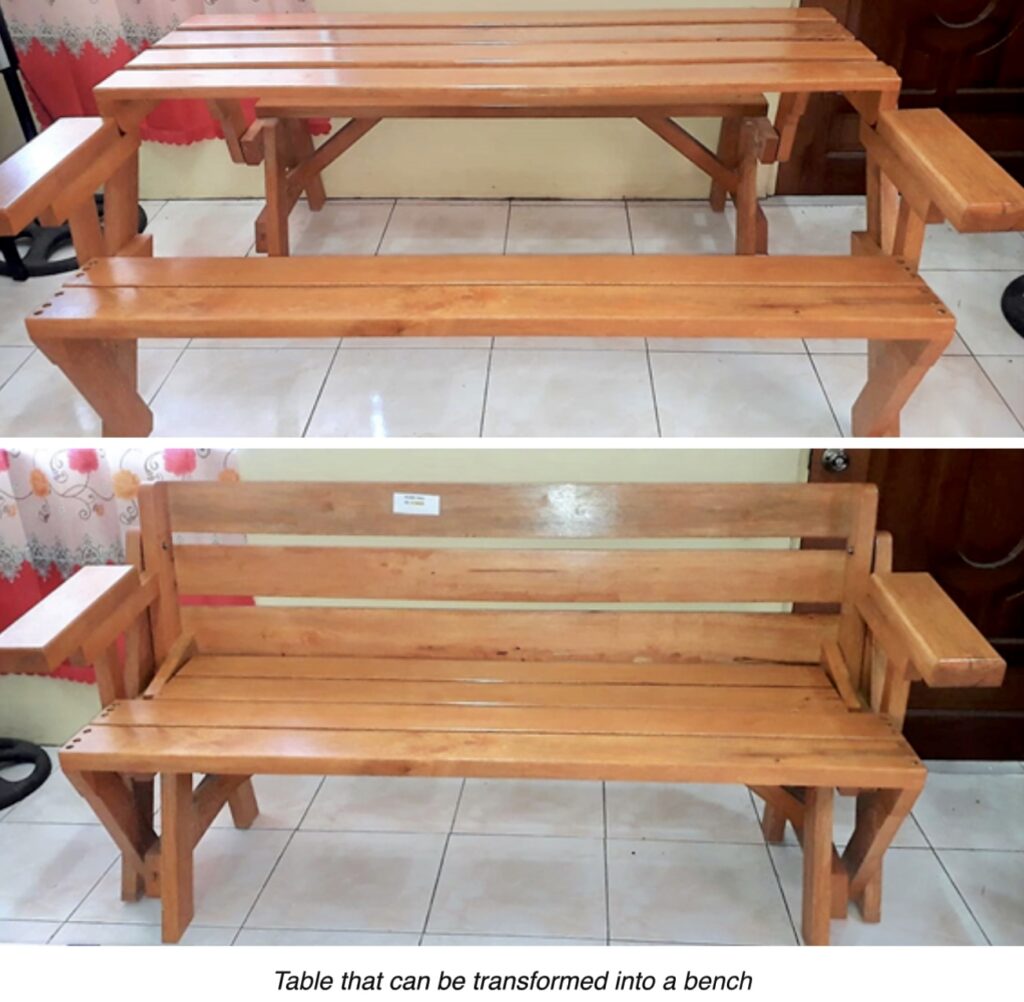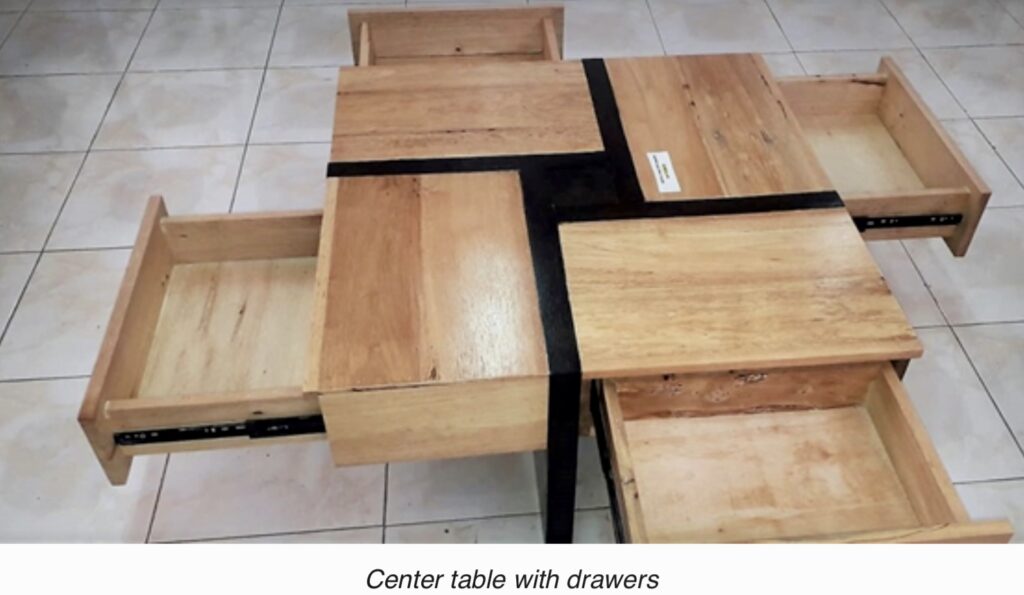By Henrylito D. Tacio
Photos courtesy of DOST
Rubber farmers who want to get rid of their trees that are no longer productive or plant another crop (like coffee, cacao, banana, or coconut) can turn the discarded trees into something valuable.
Instead of chopping them into firewood or burning them into ashes, farmers can cut them into lumber. Rubberwood, as it is known, isn’t any more elastic or soft than comparable hardwoods of similar density or weight.
Unlike most hardwood trees, the source of rubberwood is not included in the list of threatened or endangered species. In fact, rubber is not included in the appendices of the Convention of International Trade in Endangered Species of Wild Fauna and Flora (CITES) or on the red list of threatened species of the International Union of Conservation of Nature (IUCN).
Most of the rubber plantations in the Philippines are located in Regions 9, 11, and 12, accounting for 41%, 29%, and 8% of the country’s total production, according to the Ecosystems and Development Journal.
Britannica Encyclopedia states that the useful life of rubber trees is “more than 20 years,” while the website, wood-database.com, said they could be “harvested at the end of their useful life cycle – typically about after thirty years.”
Once the optimum level of production is reached, rubber trees can still be useful if they are harvested as lumber. This is especially true if they are transformed into valuable furniture. “Rubberwood furniture could be the next big thing,” said a press release issued by the Department of Science and Technology (DOST).
The profitability of rubberwood has been proven by farmers who grow rubber in the province of Zamboanga Sibugay. “Rubber farmers are now reaping the fruits of the rubberwood initiative led by the Forest Products Research and Development Institute (FPRDI),” the press statement said.

Table that can be transformed into a bench 
Center table with drawers
FPRDI is a DOST attached agency. “With the introduction of science and technology, the members of the Tambanan Agrarian Reform Beneficiaries Multi-Purpose Cooperative (TARBEMCO) started utilizing old and unproductive rubberwood trees to produce and sell furniture pieces of high quality,” the statement added.
According to Engr. Victor G. Revilleza, the project leader of the FPRDI-funded study, the locals of the said province were accustomed to using senile rubberwood trees for low-value products such as fuelwood, pallets, and crates.
“Through the DOST-FPRDI project, they learned to make high-value products which could sell for a competitive price,” Engr. Revilleza said, adding that farmers were able to acquire added knowledge on the useful application of rubberwood trees that can command higher prices in the market.
In the last three years, the FPRDI has conducted a series of training for TARBEMCO members to upgrade their skills. These include training on harvesting and sawmilling, rubberwood preservation and treatment, kiln drying, woodworking machine operation and maintenance, furniture making, and basic finishing.
Rubberwood is seen on a wide variety of (mostly inexpensive) Asian imported furniture. “Many big-box and home furnishings retailers will have pieces made out of rubberwood. When sold in this capacity, it is sometimes marketed under the ambiguous moniker ‘Plantation Hardwood,’” wood-database.com reports.
Aside from furniture, rubberwood is also used in cabinetry, interior millwork, kitchen woodenware (cutting boards, knife blocks, etc.), and other small, specialty wood items.
“Rubberwood has good qualities suitable for making furniture, packaging materials and other wooden products. It has white to pale cream color, which when dried becomes light brown. Its reasonably good strength properties make it a durable material for furniture,” Engr. Revilleza said.
Rubber (scientific name: Havea brasiliensis) is not native to the Philippines. It was introduced in the country in the early 1900s.
“Rubber trees are tapped about once every two days, yielding a cupful of latex, containing approximately 50 grams of solid rubber, each time,” Britannica Encyclopedia states. “Trees are often rested for a period after heavy tapping. Production commences when a tree is 5 or 6 years old.”
Emmanuel F. Piñol, former secretary of the Department of Agriculture, considered rubber “an amazing tree.” He explained, “Strong, long-lasting, and water and heat resistant, rubber is the perfect material for making tires for bicycles, motorcycles, cars and trucks, and aircraft.
“Soft, non-slip, and malleable enough to accommodate a large variety of colors, styles, and textures, rubber is also ideal for manufacturing playground equipment shoes, mats, flooring, healthcare supplies, household supplies, balls, toys and other products,” he added.
At the time rubber was introduced in the Philippines, the country was going through a difficult agricultural phase, Onofre T. Griño, then the president of a Filipino private corporation, told the BAR Digest, a publication of the Bureau of Agricultural Research.
“The rubber was manufactured as tires and shoes mostly came from Indonesia and Thailand. In the early 1920s, rubber wills were established in Basilan, but it was only in the 1950s when local private corporations embarked on setting up rubber processing plants in Mindanao. Today, large-scale rubber plantations are well established in the country.”
Rubber stands out as a commercial crop in the Philippines because it is highly profitable, versatile, and sustainable. In addition, growing rubber is environment-friendly. For one, its roots grow laterally or sideways. As it’s not deep-rooted, it helps maintain the topsoil. More importantly, as rubber is a tree, it is a good erosion control tool.
In terms of climate change, rubber can also be tapped in reducing the carbon dioxide released into the atmosphere. Rubber’s foliage is expansive, so it absorbs carbon dioxide significantly, contributing to the reversal in the effects of global warming.
Unfortunately, 95% of rubber growers in the Philippines are smallholders, based on a survey conducted by Dr. Tenny Alcala of the University of Southern Mindanao in Kabacan, North Cotabato.
There are also several hurdles in the growth of the industry, which include low yield per hectare due to poor management practices, poor nutritional condition of trees, lack of training for proper tapping (the method of extracting rubber sap from the tree), and poor infrastructure and marketing systems.
Another issue is the low production of latex as the trees are already old. As the trees have reached their optimum capability of producing latex, it is high time for them to be cut and the farm replanted with high-yielding varieties.
Instead of burning those cut rubber trees, the FPRDI recommends that these be turned into rubberwood and made into furniture. The Philippines, after all, is known as the “Milan of Asia.” The Philippine furniture is made of using the finest sustainably-sourced raw materials such as hardwood, rattan, bamboo, and other indigenous products. Rubberwood could be among them.
Rubberwood also called “parawood,” is durable and attractive, making it ideal for furniture pieces. “Even small pieces of rubberwood are used, by gluing them together, it creates panels which are produce table tops, trays, and chair seats,” states the website, startwoodowrkingnow.com.
In order to keep rubberwood furniture as long as possible, the aforementioned website said the wood must be protected using the following methods:
· Avoid pouring cleansers directly on the wood because it absorbs liquids.
· Prefer spraying on a fabric. Also, do not use the abrasive side of a sponge, which would remove the protective layer of varnish or oil.
· Prefer microfiber cloths to avoid marks. Just simply dust certain surfaces with a dry cloth.
· If there is more dust, wipe with a damp cloth without product and dry the surface with a dry cloth.
· If you think it is necessary, add a cleaning product (dishwashing liquid) diluted in water, wring well and rub.
But in any case, wipe your furniture as soon as cleaning is finished.

